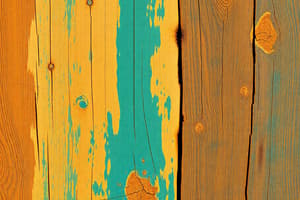Podcast
Questions and Answers
Which of the following is NOT a typical application of timber?
Which of the following is NOT a typical application of timber?
- Fuel for combustion engines (correct)
- Roofing
- Flooring
- Framing
Softwood trees are deciduous, meaning they lose their leaves annually.
Softwood trees are deciduous, meaning they lose their leaves annually.
False (B)
What is the purpose of seasoning timber?
What is the purpose of seasoning timber?
To reduce moisture content
__________ is a crucial aspect of ensuring long-term availability of timber resources.
__________ is a crucial aspect of ensuring long-term availability of timber resources.
Match the type of timber with its description:
Match the type of timber with its description:
Which of the following environmental impacts is associated with timber production?
Which of the following environmental impacts is associated with timber production?
Using timber in construction can help sequester carbon in the built environment.
Using timber in construction can help sequester carbon in the built environment.
What is one method used to preserve wood that protects it from decay and insects?
What is one method used to preserve wood that protects it from decay and insects?
Defects like _______, cracks, and decay can negatively affect the strength and appearance of timber.
Defects like _______, cracks, and decay can negatively affect the strength and appearance of timber.
Which certification scheme promotes responsible forestry management?
Which certification scheme promotes responsible forestry management?
Flashcards
Timber (Lumber)
Timber (Lumber)
Wood processed into beams and planks, used mainly for structural purposes.
Hardwood
Hardwood
Timber from deciduous trees (lose leaves annually); generally denser and more durable.
Softwood
Softwood
Timber from coniferous trees (retain leaves year-round); generally less dense and faster-growing.
Engineered Lumber
Engineered Lumber
Signup and view all the flashcards
Sustainable Forestry Management
Sustainable Forestry Management
Signup and view all the flashcards
Seasoning (Timber)
Seasoning (Timber)
Signup and view all the flashcards
Life Cycle Assessment (LCA)
Life Cycle Assessment (LCA)
Signup and view all the flashcards
Carbon Sequestration (Timber)
Carbon Sequestration (Timber)
Signup and view all the flashcards
Cross-Laminated Timber (CLT)
Cross-Laminated Timber (CLT)
Signup and view all the flashcards
Wood Preservation
Wood Preservation
Signup and view all the flashcards
Study Notes
- Timber, also known as lumber, is wood processed into beams and planks
- Timber represents a stage in wood production
Applications
- Timber's main use is for structural purposes
- Applicable in framing, roofing, and flooring
Types of Timber
- Hardwood is sourced from deciduous trees, which lose leaves annually
- Examples of hardwoods: oak, maple, and teak
- Hardwood is typically denser and more durable
- Hardwood generally costs more because it grows more slowly
- Softwood is sourced from coniferous trees, which retain leaves year-round
- Examples of softwoods: pine, fir, and cedar
- Softwood is generally less dense and grows more quickly than hardwoods
- Engineered lumber includes plywood, oriented strand board (OSB), and laminated veneer lumber (LVL)
- Engineered lumber production bonds strands, particles, fibers, or veneers of wood
- The bonding results in composite materials designed for specific properties
Forestry Management
- Sustainable forestry management is crucial for long-term timber availability
- Sustainable practices include reforestation, selective logging, and forest conservation
Timber Harvesting
- Harvesting involves cutting down trees and transporting logs to a sawmill
Timber Processing
- Sawmills process logs into various timber sizes and shapes
- Processing activities: sawing, planing, and drying
Wood Preservation
- Wood preservation extends timber's service life
- Preservation protects against decay, insects, and fire
- Preservation methods include chemical and pressure treatments
Environmental Considerations
- Timber production can significantly impact the environment
- Deforestation leads to habitat loss and carbon emissions
- Sustainable forestry practices are essential to mitigate impacts
Carbon Sequestration
- Timber stores carbon absorbed by trees during growth
- Using timber in construction can sequester carbon within the built environment
Life Cycle Assessment
- Life cycle assessment (LCA) evaluates the environmental impact of timber products
- LCA considers all stages from forest management to disposal
Grading
- Timber is graded based on quality and appearance
- Grading standards vary by region and application
Seasoning
- Seasoning reduces timber's moisture content via drying
- Seasoning improves timber stability and decay resistance
Wood Defects
- Defects like knots, cracks, and decay affect timber's strength and appearance
Woodworking
- Woodworking shapes and joins timber to create products
- Woodworking examples include furniture, cabinetry, and decorative items
Joinery
- Joinery techniques connect pieces of timber
- Examples: mortise and tenon, dovetail, and lap joints
Adhesives
- Adhesives bond timber in many applications, especially engineered wood
- Adhesive choice affects the final product's strength, durability, and environmental impact
Tools
- Various tools are used in timber processing and woodworking
- Tools range from hand tools (saws and chisels) to power tools (circular saws and planers)
Finishes
- Finishes protect timber from moisture, UV radiation, and abrasion
- Finishes also enhance appearance
- Examples: paints, varnishes, and stains
Fire Resistance
- Timber can be treated to improve fire resistance
- Fire resistance is important for construction safety
Thermal Insulation
- Timber offers good thermal insulation
- It helps reduce energy consumption in buildings
Acoustic Properties
- Timber also has good acoustic properties
- It helps reduce noise transmission in buildings
Durability
- Timber durability depends on species, treatment, and environmental conditions
- Some species are naturally more durable
Pests and Diseases
- Timber is susceptible to insects, fungi, and other pests
- Preservation techniques mitigate these risks
Standards and Regulations
- Standards and regulations govern timber production and use to ensure safety, quality, and sustainability
Building Codes
- Building codes specify timber construction requirements
- Requirements cover fire resistance, structural integrity, and moisture control
Certification
- Certification schemes like the Forest Stewardship Council (FSC) promote responsible forestry management
Cost Considerations
- Timber costs vary depending on species, grade, and availability
- Engineered lumber can be more cost-effective than solid timber
Market Trends
- The timber market is influenced by housing construction, economic growth, and environmental regulations
- There is increasing demand for sustainably sourced timber
Innovations
- Innovations in timber technology include new engineered wood products and advanced preservation techniques
- Performance and sustainability of timber construction are enhanced through these innovations
Future of Timber
- Timber is expected to play an increasingly important role in sustainable construction
- Timber's renewability and carbon sequestration potential make it an attractive building material
Applications in Construction
- Timber is used in residential, commercial, and industrial buildings
Framing Systems
- Timber framing systems provide structural support
- Examples: stud walls, beams, and trusses
Mass Timber
- Mass timber products like cross-laminated timber (CLT) are used to construct large buildings
- Mass timber products offer high strength and fire resistance
Modular Construction
- Timber is well-suited for modular construction
- Modules are prefabricated in a factory and assembled on site
Renovation and Restoration
- Timber is often used in renovation and restoration of historic buildings
- It helps maintain the original character and structural integrity
Furniture
- Timber is a popular furniture-making material because of its beauty, durability and workability
Cabinetry
- Timber is also commonly used in cabinetry and provides a warm, natural look
Flooring
- Timber flooring adds warmth and character to interiors
- Options include solid wood, engineered wood, and bamboo
Decking
- Timber decking creates outdoor living spaces
- Pressure-treated lumber and naturally durable species are used in decking
Landscaping
- Timber is used in landscaping for fences, pergolas, and other structures
- Its natural appearance blends well with environments
Studying That Suits You
Use AI to generate personalized quizzes and flashcards to suit your learning preferences.




